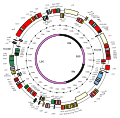A plastid is a membrane-bound organelle found in the cells of plants, algae, and some other eukaryotic organisms. Plastids are considered to be intracellular...
29 KB (3,219 words) - 10:04, 11 October 2024
Chloroplast (redirect from Secondary plastids)
chloroplast (/ˈklɔːrəˌplæst, -plɑːst/) is a type of organelle known as a plastid that conducts photosynthesis mostly in plant and algal cells. Chloroplasts...
189 KB (19,143 words) - 04:06, 11 November 2024
A plastid is a membrane-bound organelle found in plants, algae and other eukaryotic organisms that contribute to the production of pigment molecules....
10 KB (1,302 words) - 12:37, 31 August 2024
Chromoplast (category Plastids)
Chromoplasts are plastids, heterogeneous organelles responsible for pigment synthesis and storage in specific photosynthetic eukaryotes. It is thought...
11 KB (1,344 words) - 15:19, 29 August 2024
molded") are a category of plastid and as such are organelles found in plant cells. They are non-pigmented, in contrast to other plastids such as the chloroplast...
3 KB (308 words) - 22:14, 25 November 2023
Plastid terminal oxidase or plastoquinol terminal oxidase (PTOX) is an enzyme that resides on the thylakoid membranes of plant and algae chloroplasts...
15 KB (1,860 words) - 01:30, 27 December 2023
cells from prokaryotic organisms. The theory holds that mitochondria, plastids such as chloroplasts, and possibly other organelles of eukaryotic cells...
70 KB (7,519 words) - 14:54, 3 November 2024
Kleptoplasty or kleptoplastidy is a process in symbiotic relationships whereby plastids, notably chloroplasts from algae, are sequestered by the host. The word...
16 KB (1,589 words) - 08:07, 14 June 2024
Transplastomic plant (redirect from Plastid transformation)
inactivated, modified or new foreign genes are inserted into the DNA of plastids like the chloroplast instead of nuclear DNA. Currently, the majority of...
26 KB (3,091 words) - 10:22, 2 November 2023
Chloroplast DNA (redirect from Plastid genome)
strand. Notches indicate introns. Chloroplast DNA (cpDNA), also known as plastid DNA (ptDNA) is the DNA located in chloroplasts, which are photosynthetic...
54 KB (5,889 words) - 17:57, 25 October 2024
Amyloplasts are a type of plastid, double-enveloped organelles in plant cells that are involved in various biological pathways. Amyloplasts are specifically...
5 KB (633 words) - 21:37, 7 June 2024
possible ways the plastid could influence one another: (1) The mutant plastid might manufacture a substance that damaged the normal plastids during the maturation...
5 KB (541 words) - 17:30, 27 May 2024
"Prokaryota" Archaea Bacteria Mitochondrion Plastid LUCA Eukaryota Animalia Fungi Plantae 'Protista' Incertae sedis Parakaryon Microbes with highly unusual...
129 KB (11,466 words) - 09:23, 17 November 2024
Baur stated that plastids are carriers of hereditary factors which are able to mutate. in variegated plants, random sorting out of plastids is taking place...
3 KB (284 words) - 07:36, 25 October 2024
nuclei found between the inner and outer pairs of membranes in certain plastids. They are thought to be vestiges of primitive red and green algal nuclei...
11 KB (1,190 words) - 12:44, 17 April 2024
have cellulose in their cell walls, possess chlorophylls a and b and have plastids bound by only two membranes that are capable of photosynthesis and of storing...
95 KB (8,067 words) - 16:08, 5 November 2024
cryptomonads (or cryptophytes) are a group of algae, most of which have plastids. They are traditionally considered a division of algae among phycologists...
14 KB (1,398 words) - 00:24, 23 October 2024
Durinskia (section Tertiary plastid)
organelle integration since structures and organelle genomes in the tertiary plastids are not reduced. Like some dinoflagellates, species in Durinskia may cause...
16 KB (1,947 words) - 22:40, 26 July 2024
An apicoplast is a derived non-photosynthetic plastid found in most Apicomplexa, including Toxoplasma gondii, and Plasmodium falciparum and other Plasmodium...
11 KB (1,243 words) - 23:54, 26 August 2024
Maturase K (redirect from Plastid matK)
Maturase K (matK) is a plant plastidial gene. The protein it encodes is an organelle intron maturase, a protein that splices Group II introns. It is essential...
3 KB (287 words) - 15:20, 29 August 2024
non-pigmented organelles capable of alternating between the different forms of plastids. The elaioplast specifically is primarily responsible for the storage and...
9 KB (999 words) - 07:31, 12 September 2024
chlorophyll b, cellulose in the cell wall and the use of starch, stored in the plastids, as a storage polysaccharide. The charophytes and embryophytes share several...
24 KB (2,326 words) - 21:43, 4 November 2024
arise by spontaneous or induced mutation of a plastid gene, followed by the sorting-out of two kinds of plastid during vegetative growth. Alternatively, after...
57 KB (6,593 words) - 03:08, 21 November 2024
membrane-bound organelle: the plastid. This primary endosymbiosis event gave rise to three autotrophic clades with primary plastids: the (green) plants (with...
27 KB (2,663 words) - 17:15, 26 October 2024
be more closely related to each other than to the ciliates. Both have plastids, and most share a bundle or cone of microtubules at the top of the cell...
26 KB (2,664 words) - 03:34, 2 November 2024
Most Dinoflagellates have a plastid derived from secondary endosymbiosis of red algae, however dinoflagellates with plastids derived from green algae and...
96 KB (10,337 words) - 09:25, 5 November 2024
similar features in their photosynthetic organelles (plastids). It includes all eukaryotes whose plastids contain chlorophyll c and are surrounded by four...
26 KB (2,441 words) - 01:22, 10 October 2024
(2017). "Diversification of Rosaceae since the Late Cretaceous based on plastid phylogenomics". New Phytologist. 214 (3): 1355–1367. doi:10.1111/nph.14461...
80 KB (6,327 words) - 22:20, 19 November 2024
of Plastids: Genomic View on the Unification and Diversity of Plastids". In Wise, R. R.; Hoober, J. K. (eds.). The Structure and Function of Plastids. Advances...
60 KB (6,269 words) - 17:14, 21 November 2024






















